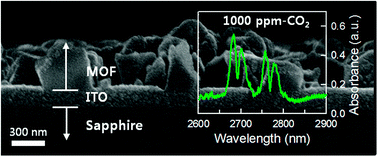Optics, nanotechnology combined to create low-cost sensor for gases

Engineers have combined innovative optical technology with nanocomposite thin-films to create a new type of sensor that is inexpensive, fast, highly sensitive and able to detect and analyze a wide range of gases.
The technology might find applications in everything from environmental monitoring to airport security or testing blood alcohol levels. The sensor is particularly suited to detecting carbon dioxide, and may be useful in industrial applications or systems designed to store carbon dioxide underground, as one approach to greenhouse gas reduction.
Oregon State University has filed for a patent on the invention, developed in collaboration with scientists at the National Energy Technology Lab or the U.S. Department of Energy, and with support from that agency. The findings were just reported in the Journal of Materials Chemistry C.
University researchers are now seeking industrial collaborators to further perfect and help commercialize the system.
"Optical sensing is very effective in sensing and identifying trace-level gases, but often uses large laboratory devices that are terribly expensive and can't be transported into the field," said Alan Wang, a photonics expert and an assistant professor in the OSU School of Electrical Engineering and Computer Science.
"By contrast, we use optical approaches that can be small, portable and inexpensive," Wang said. "This system used plasmonic nanocrystals that act somewhat like a tiny lens, to concentrate a light wave and increase sensitivity."
This approach is combined with a metal-organic framework of thin films, which can rapidly adsorb gases within material pores, and be recycled by simple vacuum processes. After the thin film captures the gas molecules near the surface, the plasmonic materials act at a near-infrared range, help magnify the signal and precisely analyze the presence and amounts of different gases.
"By working at the near-infrared range and using these plasmonic nanocrystals, there's an order of magnitude increase in sensitivity," said Chih-hung Chang, an OSU professor of chemical engineering. "This type of sensor should be able to quickly tell exactly what gases are present and in what amount."
That speed, precision, portability and low cost, the researchers said, should allow instruments that can be used in the field for many purposes. The food industry, for industry, uses carbon dioxide in storage of fruits and vegetables, and the gas has to be kept at certain levels.
Gas detection can be valuable in finding explosives, and new technologies such as this might find application in airport or border security. Various gases need to be monitored in environmental research, and there may be other uses in health care, optimal function of automobile engines, and prevention of natural gas leakage.
More information: Plasmonics-enhanced metal–organic framework nanoporous films for highly sensitive near-infrared absorption, Journal of Materials Chemistry C, DOI: 10.1039/C4TC02846E
Provided by Oregon State University



















